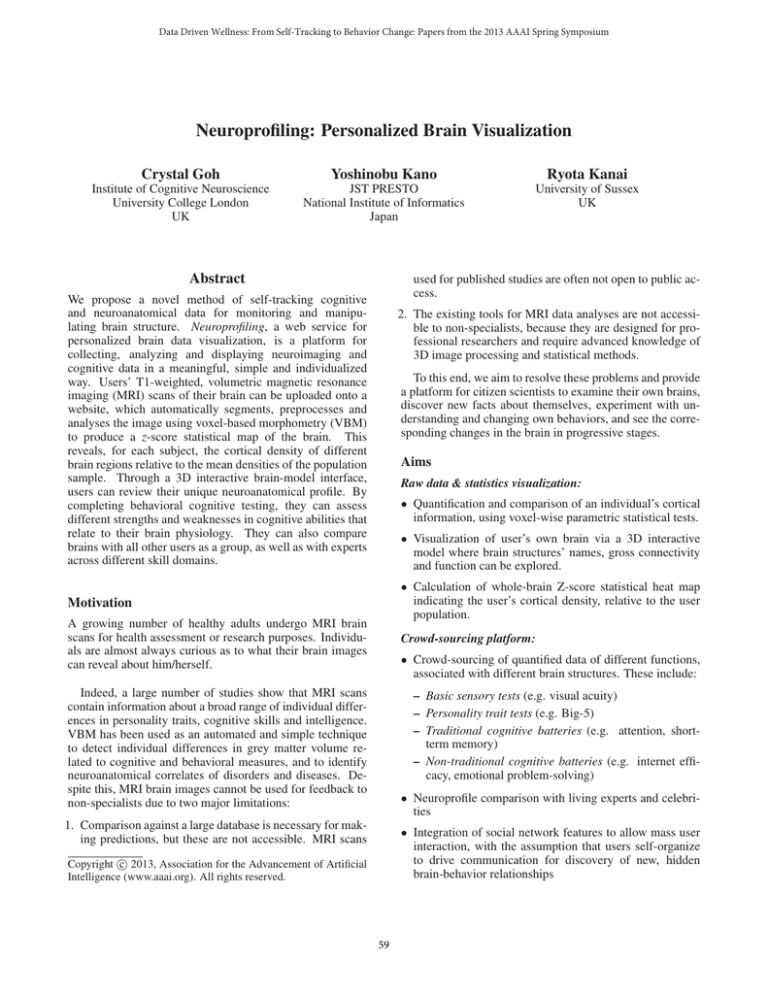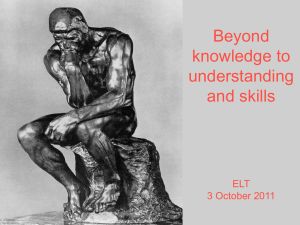Neuroprofiling: Personalized Brain Visualization Crystal Goh Yoshinobu Kano Ryota Kanai
advertisement

Data Driven Wellness: From Self-Tracking to Behavior Change: Papers from the 2013 AAAI Spring Symposium Neuroprofiling: Personalized Brain Visualization Crystal Goh Yoshinobu Kano Ryota Kanai Institute of Cognitive Neuroscience University College London UK JST PRESTO National Institute of Informatics Japan University of Sussex UK Abstract used for published studies are often not open to public access. We propose a novel method of self-tracking cognitive and neuroanatomical data for monitoring and manipulating brain structure. Neuroprofiling, a web service for personalized brain data visualization, is a platform for collecting, analyzing and displaying neuroimaging and cognitive data in a meaningful, simple and individualized way. Users’ T1-weighted, volumetric magnetic resonance imaging (MRI) scans of their brain can be uploaded onto a website, which automatically segments, preprocesses and analyses the image using voxel-based morphometry (VBM) to produce a z-score statistical map of the brain. This reveals, for each subject, the cortical density of different brain regions relative to the mean densities of the population sample. Through a 3D interactive brain-model interface, users can review their unique neuroanatomical profile. By completing behavioral cognitive testing, they can assess different strengths and weaknesses in cognitive abilities that relate to their brain physiology. They can also compare brains with all other users as a group, as well as with experts across different skill domains. 2. The existing tools for MRI data analyses are not accessible to non-specialists, because they are designed for professional researchers and require advanced knowledge of 3D image processing and statistical methods. To this end, we aim to resolve these problems and provide a platform for citizen scientists to examine their own brains, discover new facts about themselves, experiment with understanding and changing own behaviors, and see the corresponding changes in the brain in progressive stages. Aims Raw data & statistics visualization: • Quantification and comparison of an individual’s cortical information, using voxel-wise parametric statistical tests. • Visualization of user’s own brain via a 3D interactive model where brain structures’ names, gross connectivity and function can be explored. • Calculation of whole-brain Z-score statistical heat map indicating the user’s cortical density, relative to the user population. Motivation A growing number of healthy adults undergo MRI brain scans for health assessment or research purposes. Individuals are almost always curious as to what their brain images can reveal about him/herself. Crowd-sourcing platform: • Crowd-sourcing of quantified data of different functions, associated with different brain structures. These include: Indeed, a large number of studies show that MRI scans contain information about a broad range of individual differences in personality traits, cognitive skills and intelligence. VBM has been used as an automated and simple technique to detect individual differences in grey matter volume related to cognitive and behavioral measures, and to identify neuroanatomical correlates of disorders and diseases. Despite this, MRI brain images cannot be used for feedback to non-specialists due to two major limitations: – Basic sensory tests (e.g. visual acuity) – Personality trait tests (e.g. Big-5) – Traditional cognitive batteries (e.g. attention, shortterm memory) – Non-traditional cognitive batteries (e.g. internet efficacy, emotional problem-solving) • Neuroprofile comparison with living experts and celebrities 1. Comparison against a large database is necessary for making predictions, but these are not accessible. MRI scans • Integration of social network features to allow mass user interaction, with the assumption that users self-organize to drive communication for discovery of new, hidden brain-behavior relationships c 2013, Association for the Advancement of Artificial Copyright Intelligence (www.aaai.org). All rights reserved. 59 Voxel-based morphometry 2. Disruptive innovation: We aim to shift the emphasis of individual profiling methods — from older systems of purely behavior-based indices, towards metrics that integrate on demographic, behavioral, neurophysiological and genetic levels. 3. Big data analytics: Data-mining to reveal patterns for predicting new neural correlates of behavior—these inform new intervention methods for driving neuroplasticity. We aim to implement supervised machine learning models for classifying brain types as well as predicting cognitive functioning. Subjects In the current demonstration, data from 100 subjects are used. All subjects gave informed consent and the experiments were approved by the local ethics committee (University College London). Data acquisition Images are acquired on a 1.5T MR scanner (Avanto; Siemens, Erlangen, Germany). Highresolution anatomical images are acquired using a T1weighted 3D MP-RAGE sequence (TR = 1960 ms; TE = 5.6 ms; inversion time, 1100 ms; field of view, 256×224 mm2 ; matrix size, 256×224×160; voxel size 1 mm3 ) for all subjects. Support Vector Machines By training SVM on the database, we aim to identify voxel-wise patterns in a T1 MRI brain volume that predict categories such as age, lesion or atrophy. Pattern classification is based on features that include grey matter density, cortical curvature, thickness, and possibly other parameters. Segmentation Images are segmented using the unified segmentation procedure implemented in SPM5 (http://www.fil.ion.ucl.ac.uk/spm) to produce a grey matter (GM), white matter (WM) and cerebrospinal fluid (CSF) map. 3 images are produced per subject, in the same space as the original T1-weighted image. Each voxel in each map are assigned a probability of it being GM, WM and CSF respectively. Data-driven wellness At first use, the neuroprofiling system is aimed at revealing changes in mental capacity and personality that occur slowly over a period of month and years. Subsequent neuroprofile instances at shorter intervals thereafter are aimed at tracking changes in neuroanatomy based on an individualized and personally tailored battery of behavior change. Presently, behavior changes are largely tracked through behavioral data, with the emergence of basic physiological measures being implemented in this field. The bidirectional relationship between brain physiology and behavior calls for a bimodal monitoring system, which neuroprofile aims to provide. Neuroprofiling will visualize the changes in the core mental aspects of our self over a prolonged period, in terms of brain structure and cognitive ability/style. This technology will enable users to discover new facts about themselves in a completely novel way. We firmly believe that this platform harnesses the growing power of citizen science, and promotes a societal effort to examine ourselves through science. Registration GM segments are warped into a new reference space using the DARTEL algorithm for diffeomorphic image registration. GM and WM segments of all subjects are used to create a set of group specific templates and deformation fields for warping individual subject data to the new reference space. Each subject’s GM segment is then warped into the new reference space with his/her specific deformation field, resampled at 1.5 mm isotropic voxels with a trilinear interpolation, affine-transformed into Montreal Neurological Institute stereotactic space, and finally smoothed with a 8 mm full-width half maximum Gaussian kernel. We use p < 0.05 family-wise error corrected for the wholebrain volume as the criterion to detect voxels with a significant correlation with an individual’s cognitive and behavioral measurement on the above-mentioned tests. Standardization To examine GM density distribution on a single subject level relative to the population sample, zscores are then calculated for each voxel of each subject’s preprocessed GM image. The subset of voxels exceeding a threshold of z ≥ 2.0 for each individual is displayed on the prototypic template and used as a z-score map image. Audience profile The site is targeted at citizen scientists and participants of self-tracking. The early adopter may be a Quantified Self member, or an individual engaged in platforms such as 23andMe, Genomera, EyeWire, Galaxy Zoo etc. The population includes neuroscience enthusiasts, technologists, amateur/non-professional scientists, as well as patients with anomalous clinical or neuropsychological conditions. Objectives 1. Repository building: Garner a large-scale, multidimensional database of neuroimaging, cognitive and demographic data. We aim for N=3000 users as a first benchmark. 60




